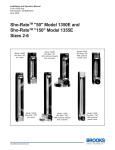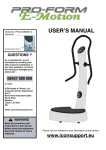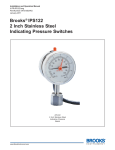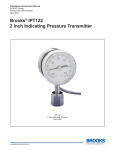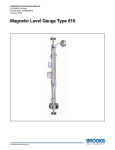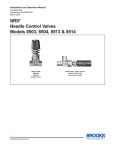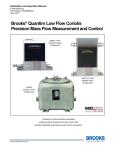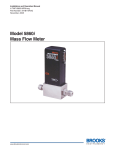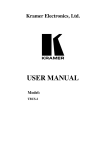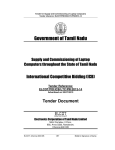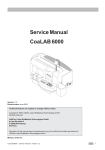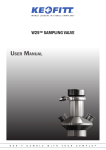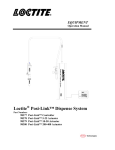Download X-PD-BM 01-02-eng Cover.pmd
Transcript
Installation and Operation Manual X-PD-BM01-02-eng Part Number: 541B042AHG March, 2008 Brooks® Models BM01 and BM02 Brooks® Oval Flowmeters, BM Oval Series BM01 and BM02 Typical BM01 and BM02 Installation and Operation Manual Brooks® Models BM01 and BM02 X-PD-BM01-02-eng Part Number: 541B042AHG March, 2008 Essential Instructions Read this page before proceeding! Brooks Instrument designs, manufactures and tests its products to meet many national and international standards. Because these instruments are sophisticated technical products, you must properly install, use and maintain them to ensure they continue to operate within their normal specifications. The following instructions must be adhered to and integrated into your safety program when installing, using and maintaining Brooks Products. • Read all instructions prior to installing, operating and servicing the product. If this instruction manual is not the correct manual, please see back cover for local sales office contact information. Save this instruction manual for future reference. • If you do not understand any of the instructions, contact your Brooks Instrument representative for clarification. • Follow all warnings, cautions and instructions marked on and supplied with the product. • Inform and educate your personnel in the proper installation, operation and maintenance of the product. • Install your equipment as specified in the installation instructions of the appropriate instruction manual and per applicable local and national codes. Connect all products to the proper electrical and pressure sources. • To ensure proper performance, use qualified personnel to install, operate, update, program and maintain the product. • When replacement parts are required, ensure that qualified people use replacement parts specified by Brooks Instrument. Unauthorized parts and procedures can affect the product's performance and place the safe operation of your process at risk. Look-alike substitutions may result in fire, electrical hazards or improper operation. • Ensure that all equipment doors are closed and protective covers are in place, except when maintenance is being performed by qualified persons, to prevent electrical shock and personal injury. Pressure Equipment Directive (PED) All pressure equipment with an internal pressure greater than 0.5 bar (g) and a size larger than 25mm or 1" (inch) falls under the Pressure Equipment Directive (PED). The Directive is applicable within the European Economic Area (EU plus Norway, Iceland and Liechtenstein). Pressure equipment can be traded freely within this area once the PED has been complied with. • Section 1 of this manual contains important safety and operating instructions related to the PED directive. • Meters described in this manual are in compliance with EN directive 97/23/EC module H Conformity Assessment. • All Brooks Instrument Flowmeters fall under fluid group 1. • Meters larger than 25mm or 1" (inch) are in compliance with category I, II, III of PED. • Meters of 25mm or 1" (inch) or smaller are Sound Engineering Practice (SEP). ESD (Electrostatic Discharge) Handling Procedure: 1. Power to unit must be removed. 2. Personnel must be grounded, via a wrist strap or other safe, suitable means before any printed circuit card or other internal device is installed, removed or adjusted. 3. Printed circuit cards must be transported in a conductive container. Boards must not be removed from protective enclosure until immediately before installation. Removed boards must immediately be placed in protective container for transport, storage or return to factory. Comments This instrument is not unique in its content of ESD (electrostatic discharge) sensitive components. Most modern electronic designs contain components that utilize metal oxide technology (NMOS, SMOS, etc.). Experience has proven that even small amounts of static electricity can damage or destroy these devices. Damaged components, even though they appear to function properly, exhibit early failure. Installation and Operation Manual X-PD-BM01-02-eng Part Number: 541B042AHG March, 2008 Brooks® Models BM01 and BM02 Dear Customer, We appreciate this opportunity to service your flow measurement and control requirements with a Brooks Instrument device. Every day, flow customers all over the world turn to Brooks Instrument for solutions to their gas and liquid low-flow applications. Brooks provides an array of flow measurement and control products for various industries from biopharmaceuticals, oil and gas, fuel cell research and chemicals, to medical devices, analytical instrumentation, semiconductor manufacturing, and more. The Brooks product you have just received is of the highest quality available, offering superior performance, reliability and value to the user. It is designed with the ever changing process conditions, accuracy requirements and hostile process environments in mind to provide you with a lifetime of dependable service. We recommend that you read this manual in its entirety. Should you require any additional information concerning Brooks products and services, please contact your local Brooks Sales and Service Office listed on the back cover of this manual or visit www.BrooksInstrument.com Yours sincerely, Brooks Instrument Installation and Operation Manual Brooks® Models BM01 and BM02 THIS PAGE WAS INTENTIONALLY LEFT BLANK X-PD-BM01-02-eng Part Number: 541B042AHG March, 2008 Installation and Operation Manual X-PD-BM01-02-eng Part Number: 541B042AHG March, 2008 Contents Brooks® Models BM01 and BM02 Paragraph Page Number Number Section 1 Introduction 1-1 Scope ......................................................................................................................................... 1-1 1-2 Description ................................................................................................................................. 1-1 1-3 Specifications ............................................................................................................................. 1-1 Section 2 Installation 2-1 General ...................................................................................................................................... 2-1 2-2 Receipt of Equipment ................................................................................................................. 2-1 2-3 Recommended Storage Practice ............................................................................................... 2-1 2-4 Return Shipment ........................................................................................................................ 2-2 2-5 Transit Precaution ...................................................................................................................... 2-2 2-6 Transit Precaution ...................................................................................................................... 2-2 2-7 Installation .................................................................................................................................. 2-3 2-8 Pre-Operation Procedures ......................................................................................................... 2-6 Section 3 Operation 3-1 General ...................................................................................................................................... 3-1 3-2 Flowmeter Principle of Operation (See Figure 3-1) .................................................................... 3-1 3-3 Pulse Generator Principle of Operation (See Figure 3-1) .......................................................... 3-2 3-4 Operating Instructions ................................................................................................................ 3-2 3-5 Operating Precautions ............................................................................................................... 3-2 3-6 Precautions at Operation Shutdown ........................................................................................... 3-3 Paragraph Page Number Number Section 4 Maintenance 4-1 General ...................................................................................................................................... 4-1 4-2 Manufacturer's Maintenence Recommendations ....................................................................... 4-1 4-3 Disassembly - General ............................................................................................................... 4-2 4-4 Disassembly - Flowmeter (Refer to Figure 4-1) ......................................................................... 4-3 4-5 Cleaning ..................................................................................................................................... 4-3 4-6 Assembly - Flowmeter (Refer to Figure 4-1) .............................................................................. 4-3 4-7 Troubleshooting (See Table 4-1) ................................................................................................ 4-4 Section 5 Parts List 5-1 General ...................................................................................................................................... 5-1 Warranty, Local Sales/Service Contact Information ....................................................................... Back Cover i Contents Brooks® Models BM01 and BM02 Installation and Operation Manual X-PD-BM01-02-eng Part Number: 541B042AHG March, 2008 Figures Figure Page Number Number 1-1 Typical Meter Error and Pressure Drop ....................................................................................... 1-3 1-2 Dimensions ................................................................................................................................. 1-3 2-1 Proper Orientation of Meter Assembly ........................................................................................ 2-4 2-2 Typical Installation for Fuel Metering ........................................................................................... 2-4 2-3 Horizontal Installation .................................................................................................................. 2-5 2-4 Vertical Installation ...................................................................................................................... 2-5 2-5 Electrical Connections ................................................................................................................ 2-6 3-1 Principle of Operation ................................................................................................................. 3-3 4-1 Assembly/Disassembly Diagram ................................................................................................ 4-4 5-1 Exploded Parts Drawing .............................................................................................................. 5-2 Tables Table Page Number Number 4-1 Troubleshooting .......................................................................................................................... 4-5 5-1 Spare Parts List .......................................................................................................................... 5-2 ii Installation and Operation Manual Introduction X-PD-BM01-02-eng Part Number: 541B042AHG March, 2008 Brooks® Models BM01 and BM02 1-1 Scope The Brooks® BM Series Flowmeters, hereafter called flowmeters, are positive displacement meters that maesure extremely low flows of clean liquid with high accuracy. The flowmeter generates an electrical signal proportional to flow for use with a wide variety of electronic instruments. 1-2 Description The flowmeters have incorporated the oval rotor principle into its design. This has proven to be a reliable and highly accurate method of measuring flow. Exceptional repeatability and high accuracy over a wide range of viscosities and flow rates are features of the flowmeters. The low pressure drop and high pressure rating means the flowmeters are suitable for both gravity and pump (in line) applications. 1-3 Specifications Capacities Viscosity BM01 BM02 .3 to 8cP 1.32 to 26 gph (5 to 100 lph) 6 to 132 gph (25 to 500 lph) 5 to 1,000cP 0.53 to 26 gph (2 to 100 lph) 4 to 132 gph (15 to 500 lph) Performance Accuracy: +/- 1% Repeatability: 0.03% Typical meter performance and pressure drop: Figure 1-1. Ratings Maximum working pressure: PPS body: 75 PSIG (500 KPAG) 316 SS body: 150 PSIG (1000 KPAG) Consult factory for higher pressure options. Maximum working temperature: PPS body and/or Rotors (Gears): 176° F (80° C). 316 SS body and Rotors (Gears): 248° F (120° C). Ambient Temperature: -4° F to 104° F (-20° C to +40° C). 1-1 Installation and Operation Manual Introduction Brooks® Models BM01 and BM02 X-PD-BM01-02-eng Part Number: 541B042AHG March, 2008 Outputs Note: each meter contains both switch types Reed Switch Detection Method: Reed Switch, Two wire SPST N/O contact. Max. Voltage: 150 VDC maximum. Contact Capacity: 0.25 AMPS Rating 3 Watts. Termination: 39 inch (1 meter) flying lead. Nominal K-Factor: Model BM01: 1000 p/l (3785.4p/gal) Model BM02: 400 p/l (1514.2 p/gal) Hall Effect Switch Detection Method: Hall effect switch Response Frequency: 1,000 Hz maximum Output Pulse: Unfactored voltage pulse Input/Output = 4.5 to 24 VDC (4.6 ~ 9 mA) Open Collector 25 mA output NPN compatible with digital logic. Reverse power protection. Termination: 39 inch (1 meter) flying lead Nominal K-Factor: Model BM01: 1000 p/l (3785.4p/gal) Model BM02: 400 p/l (1514.2 p/gal) Meter Materials of Construction Meter Body: PPS (Polyphenylene Sulfide) or 316 Stainless Steel. Rotors(Gears): BM01 / BM02 - PPS or 316 Stainless Steel, 316 Stainless Steel only for High Viscosity. Bearings: BM01 / BM02 Zirconia. Note: (316 PPS Rotors No Bearings Required) Rotors (Gears) Shafts: 316 Stainless Steel or Optional Hastelloy® C (PPS body only). O-Rings: Standard Viton® or Optional Teflon®. Connections ¼ inch NPT (female) Dimensions Refer to Figure 1-2 For certified dimensional prints, contact the factory. Pressure Equipment Directive (97/23/EC) Equipment falls under Sound Engineering practice (SEP) according to the directive. 1-2 Installation and Operation Manual X-PD-BM01-02-eng Part Number: 541B042AHG March, 2008 Introduction Brooks® Models BM01 and BM02 Figure 1-1 Typical Meter Error and Pressure Drop Shipping Weight (Approximate) Body BM01 BM02 PPS .53lbs. .24Kg. .53lbs. .24Kg. Stainless Steel 1.32lbs. .60Kg. 1.32lbs. .60Kg. For certified dimension prints, consult factory. Figure 1-2 Dimensions 1-3 Installation and Operation Manual Introduction Brooks® Models BM01 and BM02 THIS PAGE WAS INTENTIONALLY LEFT BLANK 1-4 X-PD-BM01-02-eng Part Number: 541B042AHG March, 2008 Installation Installation and Operation Manual X-PD-BM01-02-eng Part Number: 541B042AHG March, 2008 Brooks® Models BM01 and BM02 2-1 General This section contains the procedures for the receipt and installation of the instrument. See Section 1 for dimensional and connection requirements. Do not attempt to start the system until the instrument has been permanently installed. It is important that the start-up procedures be followed in the exact sequence presented. 2-2 Receipt of Equipment When the instrument is received, the outside packing case should be checked for damage incurred during shipment. If the packing case is damaged, the local carrier should be notified at once regarding his liability. A report should be submitted to your nearest Product Service Department. Brooks Instrument 407 W. Vine Street P.O. Box 903 Hatfield, PA 19440 USA Toll Free (888) 554-FLOW (3569) Tel (215) 362-3700 Fax (215) 362-3745 E-mail: [email protected] www.BrooksInstrument.com Brooks Instrument Neonstraat 3 6718 WX Ede, Netherlands P.O. Box 428 6710 BK Ede, Netherlands Tel 31-318-549-300 Fax 31-318-549-309 E-mail: [email protected] Brooks Instrument 1-4-4 Kitasuna Koto-Ku Tokyo, 136-0073 Japan Tel 011-81-3-5633-7100 Fax 011-81-3-5633-7101 Email: [email protected] Remove the envelope containing the packing list. Carefully remove the instrument from the packing case. Make sure spare parts are not discarded with the packing materials. Inspect for damaged or missing parts. 2-3 Recommended Storage Practice If intermediate or long-term storage of equipment is required, it is recommended that the equipment be stored in accordance with the following conditions: a. Within the original shipping container. b. Stored in a sheltered area, preferably a warm, dry, heated warehouse. c. Ambient temperature 21°C (70°F) nominal, 32°C (90°F) maximum, 45°F (7°C) minimum. d. Relative humidity 45% nominal, 60% maximum, 25% minimum. 2-1 Installation Installation and Operation Manual Brooks® Models BM01 and BM02 X-PD-BM01-02-eng Part Number: 541B042AHG March, 2008 2-4 Return Shipment Prior to returning any instrument to the factory, contact your nearest Brooks location for a Return Materials Authorization Number (RMA#). This can be obtained from one of the following locations: Brooks Instrument 407 W. Vine Street P.O. Box 903 Hatfield, PA 19440 USA Toll Free (888) 554-FLOW (3569) Tel (215) 362-3700 Fax (215) 362-3745 E-mail: [email protected] www.BrooksInstrument.com Brooks Instrument Neonstraat 3 6718 WX Ede, Netherlands P.O. Box 428 6710 BK Ede, Netherlands Tel 31-318-549-300 Fax 31-318-549-309 E-mail: [email protected] Brooks Instrument 1-4-4 Kitasuna Koto-Ku Tokyo, 136-0073 Japan Tel 011-81-3-5633-7100 Fax 011-81-3-5633-7101 Email: [email protected] Any instrument returned to Brooks requires completion of Form RPR003-1, Brooks Instrument Decontamination Statement, as well as, a Material Safety Data Sheet (MSDS) for the fluid(s) used in the instrument. This is required before any Brooks Personnel can begin processing. Copies of the form can be obtained from any Brooks Instrument location listed above. 2-5 Transit Precautions To safeguard against damage during transit, transport the instrument to the installation site in the same container used for transportation from the factory if circumstances permit. 2-6 Removal from Storage Upon removal of the instrument from storage, a visual inspection should be conducted to verify its "as-received" condition. If the instrument has been subject to storage conditions in excess of those recommended (See Section 2-3), it should be subjected to a pneumatic pressure test in accordance with applicable vessel codes. 2-2 Installation and Operation Manual X-PD-BM01-02-eng Part Number: 541B042AHG March, 2008 Installation Brooks® Models BM01 and BM02 2-7 Installation To provide for optimum system performances the following guidelines should be observed: 1. Before use, confirm the fluid to be used is compatible with the meter. 2. The flowmeter must be installed so the shafts of the rotors are horizontal, never vertical or “on end”. Severe damage to components may be the result, (See Figure 2-1). 3. A 200 mesh strainer should be installed upstream and adjacent to the flowmeter to protect it from foreign matter (.003"/.075mm Maximum), such as dirt, pipe scale, or welding splatter, (See Figures 2-3 and 2-4). 4. Valves should be installed to facilitate removal of the flowmeter and strainer, (See Figures 2-3 and 2-4). 5. Install the flowmeter on the discharge side of a pump whenever possible. 6. Before installing the flowmeter, wash and clean the inside of the pipeline with compressed air or steam. This is particularly important on new pipelines. 7. Remove the protective covering from the flowmeter end connectors before installation. 8. When making connection to the flowmeter make certain that no foreign materials enter flowmeter body. 9. Flexible piping is recommended. 10. Refer to Figure 2-5 for electrical connections. 2-3 Installation Installation and Operation Manual X-PD-BM01-02-eng Part Number: 541B042AHG March, 2008 Brooks® Models BM01 and BM02 Important Note: Rotorshafts shafts Note: Rotor aremust parallel to always be parallel to the theground. ground. INLET FLOW F L O W FLOW INLET F L O W Horizontal Installation Figure 2-1 Proper Orientation of Meter Assembly Figures 2-2 Typical Installation for Fuel Metering 2-4 Vertical Installation Installation Installation and Operation Manual X-PD-BM01-02-eng Part Number: 541B042AHG March, 2008 Brooks® Models BM01 and BM02 HORIZONTAL LINE OVAL GEAR FLOWMETER Inlet Valve Outlet Valve STRAINER Control Valve Drain Valve Bypass Valve Figures 2-3 Horizontal Installation VERTICAL LINE Control Valve Outlet Valve OVAL GEAR FLOWMETER Bypass Valve STRAINER Inlet Valve Drain Valve Figures 2-4 Vertical Installation 2-5 Installation Installation and Operation Manual X-PD-BM01-02-eng Part Number: 541B042AHG March, 2008 Brooks® Models BM01 and BM02 RED WIRE HALL SENSOR POWER (+) HALL VOLTAGE RANGE BLACK WIRE HALL SENSOR NEGATIVE (-) HALL MAX. RATED CURRENT 24 mA WHITE WIRE HALL SENSOR SIGNAL HALL CONNECTION 1K ohm Pull up resistor fitted YELLOW WIRE REED SENSOR CONNECTION REED MAX. VOLTAGE 30 V GREEN WIRE REED SENSOR CONNECTION REED MAX. CURRENT REED LIFE (TYPICAL) 0.5 A 500 x 10^6 cycles 10 Vdc @ 10 mA 4.5 - 24 Vdc Figure 2-5 Electrical Connections 2-8 Pre-Operation Procedures After the flowmeter has been installed, slowly allow the liquid to flow in bypass section of a horizontal installation or the main line of a vertical installation. This will clear the line of any foreign particles. NOTE: Foreign particles in the main line may cause damage to the flowmeter. 2-6 Operation Installation and Operation Manual X-PD-BM01-02-eng Part Number: 541B042AHG March, 2008 Brooks® Models BM01 and BM02 3-1 General The flowmeter has been completely assembled, checked and calibrated at the factory. Therefore, no adjustments are required for installation. 3-2 Flowmeter Principle of Operation (See Figure 3-1) The Oval Flowmeter accurately measures liquid flow by using a slight pressure differential to rotate a pair of oval gears. The meshed gears seal the inlet from the outlet flow, developing the pressure differential. When in the position as shown in Figure 3-1A, Gear A receives torque from the pressure difference, the torque upon Gear B cancel one another, and Gear A drives Gear B as depicted in Figure 3-1B. When Gear A rotates to the position as shown in Figure 3-1C, it loses torque, but Gear B obtains torque and drives Gear A. This alternate driving action provides a smooth rotation of almost constant torque without dead spots. Figures 3-1D, 3-1E, 3-1F, 3-1G, 3-1H, and 3-1J illustrate this principle through a complete cycle bringing Gear A back to its original position as shown in Figure 3-1A. 2 B B 1 A A During rotor rotation, the rotors trap precise quantities of liquid in the crescent shaped gaps or measuring chambers. Total quantity of flow for one complete cycle of the rotors is four times that of the crescent shaped gap. Rate of flow is proportional to the rotation speed of the rotors. Because the amount of slippage between the rotors and the measurement chamber wall is minimal, the flowmeter is essentially unaffected by changes in viscosity and lubricity of the liquid. 3 A B 3-1B 3-1A 3-1C FLOW A A 6 B B A 5 4 B 3-1E 3-1D 3-1F FLOW 9 B 8 B 7 B A A A 3-1G 3-1H 3-1J Figure 3-1 Principle of Operation 3-1 Operation Installation and Operation Manual Brooks® Models BM01 and BM02 X-PD-BM01-02-eng Part Number: 541B042AHG March, 2008 3-3 Pulse Generator Principle of Operation (See Figure 3-1) A magnet is installed in one end of oval gear “A”. As this magnet passes by the metal contacts of the reed switch or MR Sensor contained in the cover, it will cause the switch to close. Each time the reed switch or MR Sensor closes, it completes the circuit representing one pulse to the counting circuit. 3-4 Operating Instructions At initial operation, carefully operate in the following sequence, allowing the flow within the flow range specified. (Refer to Figures 2-3 and 2-4). 1. Shut off the valve (A) on the inlet side and the valve (B) on the outlet side and then open the bypass line valve (C) to allow the fluid in the bypass line, thereby removing weld chips, scales and other foreign matter left in the piping assembly. NOTE: This is particularly important on new installations. 2. Carefully and slightly at first, open the valve (A) upstream of the meter progressively and then, slightly at first, open the valve (B) downstream progressively. 3. Slowly close the bypass line valve (C) and make sure that the total counter in the receiving instrument advances in response. Maintain a flowrate 10 to 20% of the maximum flowrate at this time, allow the flow for more than 15 minutes and make sure that air in the piping assembly has totally escaped. NOTE: In applications where temperatures exceed 60° C (140° F), run the system at least for 30 minutes in this state to ensure uniform heat distribution in the measuring chamber. 4. Following the break-in operation (preheating), shut off the bypass line valve (C) completely. Open the upstream valve (A) progressively until fully open then slowly open the downstream valve (B) until the rated flow is reached. 5. Flowrate should be regulated with the downstream valve (B) and should be held within the rating. 6. The strainer should be inspected for condition and cleaned on a regular basis. 3-5 Operating Precautions Periodic inspections should be made during flowmeter operation. The following points should be checked and the flowmeter shut down if any discrepancy is found. 3-2 1. When changing flowrates In applications where the flowrate varies or where shut-off valve opening and closure takes place in batch operation, avoid rapid changes in flowrate across the meter. Operation Installation and Operation Manual X-PD-BM01-02-eng Part Number: 541B042AHG March, 2008 Brooks® Models BM01 and BM02 Operating the meter at flowrates in excess of the maximum allowable flowrate will nullify the guaranteed accuracy, reduce the meter life and may result in faulty conditions, such as seizure of bearings or rotor-tomeasuring chamber contact. 2. Where the temperature of metered fluid changes Avoid rapid temperature changes in the meter. Temperature changes of the fluid in the meter should be held within 3° C, 37° F per minute. Extra care should be used particularly when making a flow measurement in batch operation without the provision of heat tracing of the piping where the fluid temperature differs from atmospheric temperature. NOTE: If rapid temperature changes are anticipated, heat trace the piping assembly as well as the meter. 3. Liquids of low steam pressure Liquids with low viscosity and low steam pressure are prone to vaporize and their temperature and pressure should, therefore, be strictly controlled. During operation, the temperature of bearings in the meter is usually higher than that of the metered fluid. Vapors around the bearings can be causes of faulty conditions, including generation of unusual noise and bearing seizure. 4. Corrosive liquids When you make a measurement of highly corrosive liquids, appropriate materials should be used for tanks and piping assembly. Heterogeneous materials originally contained in the metered fluid or corrosive substances liquated out from tanks and pipes of inappropriate materials may lock the rotors in the measuring chamber and lead to costly downtime. 3-6 Precautions at Operation Shutdown 1. Valves should be closed progressively. Rapid valve closure could, under certain piping conditions, cause a sharp pressure rise by water hammer, or hydraulic shock, resulting in damage to the meter. 2. Precautions against pressure buildup on closure. Complete closure of valves upstream and downstream of the meter produces a totally enclosed space between the valves. A pressure buildup relative to a rise in atmospheric temperature could lead to damage to the meter. 3. Liquids that readily adhere or gel. Liquids that tend to adhere and solidify or gel at flow velocities around zero must thoroughly be washed away from the meter interior with running cleaning fluid before shutdown. Negligence of this precaution could produce an immovable mass of components when the operator attempts to resume meter operation. NOTE: Turn pump off at end of each day. After the flowmeter has been installed, slowly allow the liquid to flow in bypass section of a horizontal installation or the main line of a vertical installation. This will clear the line of any foreign particles. 3-3 Operation Installation and Operation Manual X-PD-BM01-02-eng Part Number: 541B042AHG March, 2008 Brooks® Models BM01 and BM02 THIS PAGE WAS INTENTIONALLY LEFT BLANK 3-4 Installation and Operation Manual X-PD-BM01-02-eng Part Number: 541B042AHG March, 2008 Maintenance Brooks® Models BM01 and BM02 4-1 General No routine maintenance, cleaning or lubrication is required on the flowmeter. The user should establish a schedule for the periodic checking and cleaning of the strainer. Cleaning the strainer depends upon product application and time of use. 4-2 Manufacturer's Maintenance Recommendations The following items apply to all flowmeters. Users must give careful consideration to the consequences that may be the result of failure to follow manufacturer’s recommendations. 1. No attempt should be made by the user to alter any physical dimension of the flowmeter or component part. 2. Do not use force to assemble or disassemble any component of the flowmeter. All components are machined to exact tolerances. 3. When an unserviceable flowmeter has been returned to the factory for rework, it must be understood that in extreme cases it may be economically impractical to repair the flowmeter. 4. Rotors are manufactured as a subassembly and are available as replacement parts, or spare parts. 4-1 Installation and Operation Manual Maintenance Brooks® Models BM01 and BM02 X-PD-BM01-02-eng Part Number: 541B042AHG March, 2008 4-3 Disassembly - General Before proceeding with any disassembly, follow these steps: 1. Close all valves and isolate the meter from line pressure or back pressure. 2. If used at elevated temperatures, reduce temperature of meter (including internals) to ambient. 3. Disconnect any electrical lines to or from the meter. 4. (See Figure 4-1) Reduce the pressure inside the meter to zero by draining that section of the line which is isolated along with the meter. A method other than removing the cover (Item 2) of the meter should be used if available, i.e. strainer, drain plug, etc. If the pressure must be reduced through the flowmeter, very slowly and carefully crack the screws (Item 3) in the cover (Item 2) until the meter begins to drain slowly thereby reducing the pressure to zero. 5. (See Figure 4-1) Drain the flowmeter completely by removing the cover (Item 2) carefully. 6. Disconnect all tubing and/or wiring from meter mounted accessories. 4-2 Installation and Operation Manual X-PD-BM01-02-eng Part Number: 541B042AHG March, 2008 Maintenance Brooks® Models BM01 and BM02 4-4 Disassembly - Flowmeter (Refer to Figure 4-1) Never use any gripping tool on any internal component of the meter. Do not drop any part of the meter or damage can occur. 1. Remove four (4) screws (Item 3) and remove meter body cover (Item 2). 2. Remove O-ring (Item 5) and inspect. (Replace O-ring if damaged). 3. Remove rotors (Item 4), clean and inspect (Replace rotors if damaged). 4-5 Cleaning Clean and inspect all parts removed from the flowmeter assembly. It is recommended to wash all parts thoroughly in a light weight solvent. Dry thoroughly with compressed air and/or lint free wipers. 4-6 Assembly - Flowmeter (Refer to Figure 4-1) It is recommended that new O-Rings be installed upon assembly. No lubricant is recommended or required for the O-Rings. The following steps are required for meter assembly. 1. Place the rotors (Item 4) into the meter body. The rotors to be at 90° to each other (As per diagram). NOTE: The rotor with magnets must be placed in the body on the same side as the groove on the body (Refer to diagram). 2. Lightly rotate the rotors (Item 4) by hand (They must rotate freely). 3. If the rotor (Item 4) teeth mesh is not correct, disengage one rotor (Item 4) and rotate it one tooth clockwise or counterclockwise, then engage teeth again. Repeat this procedure until the rotors (Item 4) are properly meshed and will turn freely through several revolutions. 4. Install O-Ring (Item 5). 5. Replace meter cap (Item 2). NOTE: The grove on the cover must line up with the groove on the meter body (Refer to Figure 4-1). 6. Replace four screws (item 3). 4-3 Installation and Operation Manual Maintenance Brooks® Models BM01 and BM02 X-PD-BM01-02-eng Part Number: 541B042AHG March, 2008 4-7 Troubleshooting (See Table 4-1) The troubleshooting table is presented as an aid in locating and correcting operational problems in the meter. The user must understand that every possible problem could not be listed. However, the table will provide adequate information for general field repairs. Figure 4-1 Assembly/Disassembly Diagram 4-4 Installation and Operation Manual X-PD-BM01-02-eng Part Number: 541B042AHG March, 2008 Maintenance Brooks® Models BM01 and BM02 Table 4-1 Troubleshooting Symptom 1. Counter will not count. Possible Causes 1. Flowrate low. 2. Pump pressure or head pressure low. 3. Oval rotors are jammed with foreign matter. 4. Faulty hall effect sensor or reed switch. 5. Faulty magnet. 6. Rotors installed in wrong position. 2. Liquid leaks. 1. Incomplete pipe seals. 2. Incomplete front cover seal of the meter body. Remedy 1. Open the valve progressively. 2. Taking pressure loss of the entire piping system into account, select a proper pump pressure or head pressure. 3. Disassemble the meter body by referring to the meter body disassembly and inspection procedure. Wash clean the rotors and related components. 4. Replace meter cap. 5. Replace rotors. 6. Refer to correct rotor positioning assembly instructions. 1. Check and tighten pipe connections or replace gaskets. 2. Check front cover fitting bolts for tightness and replace O-Ring with new one. 3. Counts while the valve remains closed. 1. Liquid leaks from valves or pipe connections. 2. Air builds up somewhere between the valve and meter; pulsating pump pressure causes a rocking motion of the rotors. 1. Inspect valves and pipe connections for condition. 2. Let the air escape. Provide a check valve and accumluator. 4. Meter reading inaccurate. 1. Fluid flowrate is too low or too high. 2. Air in fluid. 3. Excess wear caused by incorrect installation. 1. See "Specifications" for minimum and maximum flowrates. 2. Bleed air from system. 3. Check meter body and rotors. Replace as required. See "Installation" instructions. 5. Fluid will not flow through meter. 1. Foreign matter blocking rotors. 4. Meter connections over tightened. 1. Dismantle meter, clean rotors (strainer must be fitted in line). 2. Clean strainer. 3. Replace rotors (strainer must be fitted in line). 4. Readjust connections. 1. Line strainer partially blocked. 2. Fluid is too viscous. 1. Clean strainer. 2. Max. viscosity 1000 centipoise. 2. Line strainer blocked. 3. Damaged rotors. 6. Reduced flow through the meter. 4-5 Installation and Operation Manual Maintenance Brooks® Models BM01 and BM02 THIS PAGE WAS INTENTIONALLY LEFT BLANK 4-6 X-PD-BM01-02-eng Part Number: 541B042AHG March, 2008 Installation and Operation Manual X-PD-BM01-02-eng Part Number: 541B042AHG March, 2008 Parts List Brooks® Models BM01 and BM02 5-1 General This section contains the necessary parts required to make up any standard unit that is covered in this instruction manual. Each parts list also contains the recommended spare and replacement parts denoted by an asterisk. For items that are not listed or require additional information, consult the factory. When ordering, the following information must be furnished: Part number and description Model number of flowmeter Serial number of flowmeter Quantity required When ordering items of a material or special construction not indicated in the Parts List, furnish the following information so that the part number of the item can be determined. Item number and description Specific material of item Model number of flowmeter Serial number of flowmeter Quantity required 5-1 Installation and Operation Manual Parts List Brooks® Models BM01 and BM02 Figure 5-1 Exploded Parts Drawing Table 5-1 Spare Parts List Item No. Part Name 1 Meter Body Assembly 2 5-2 Meter Cap - Hall/Reed Effect 3 Screws 4 Rotor (Set) 5 O-Ring (Viton) X-PD-BM01-02-eng Part Number: 541B042AHG March, 2008 Installation and Operation Manual X-PD-BM01-02-eng Part Number: 541B042AHG March, 2008 Brooks® Models BM01 and BM02 THIS PAGE WAS INTENTIONALLY LEFT BLANK Installation and Operation Manual X-PD-BM01-02-eng Part Number: 541B042AHG March, 2008 Brooks® Models BM01 and BM02 LIMITED WARRANTY Seller warrants that the Goods manufactured by Seller will be free from defects in materials or workmanship under normal use and service and that the Software will execute the programming instructions provided by Seller until the expiration of the earlier of twelve (12) months from the date of initial installation or eighteen (18) months from the date of shipment by Seller. Products purchased by Seller from a third party for resale to Buyer (“Resale Products”) shall carry only the warranty extended by the original manufacturer. All replacements or repairs necessitated by inadequate preventive maintenance, or by normal wear and usage, or by fault of Buyer, or by unsuitable power sources or by attack or deterioration under unsuitable environmental conditions, or by abuse, accident, alteration, misuse, improper installation, modification, repair, storage or handling, or any other cause not the fault of Seller are not covered by this limited warranty, and shall be at Buyer’s expense. Goods repaired and parts replaced during the warranty period shall be in warranty for the remainder of the original warranty period or ninety (90) days, whichever is longer. This limited warranty is the only warranty made by Seller and can be amended only in a writing signed by an authorized representative of Seller. BROOKS LOCAL AND WORLDWIDE SUPPORT Brooks Instrument provides sales and service facilities around the world, ensuring quick delivery from local stock, timely repairs and local based sales and service facilities. Our dedicated flow experts provide consultation and support, assuring successful applications of the Brooks flow measurement and control products. Calibration facilities are available in local sales and service offices. The primary standard calibration equipment to calibrate our flow products is certified by our local Weights and Measures Authorities and traceable to the relevant international standards. START-UP SERVICE AND IN-SITU CALIBRATION Brooks Instrument can provide start-up service prior to operation when required. For some process applications, where ISO-9001 Quality Certification is important, it is mandatory to verify and/or (re)calibrate the products periodically. In many cases this service can be provided under in-situ conditions, and the results will be traceable to the relevant international quality standards. CUSTOMER SEMINARS AND TRAINING Brooks Instrument can provide customer seminars and dedicated training to engineers, end users and maintenance persons. Please contact your nearest sales representative for more details. HELP DESK In case you need technical assistance: 1-888-554-FLOW Americas Europe +(31) 318 549 290 Within Netherlands Asia +011-81-3-5633-7100 0318 549 290 Due to Brooks Instrument's commitment to continuous improvement of our products, all specifications are subject to change without notice. TRADEMARKS Brooks ................................................................. Brooks Instrument, LLC Hastelloy ................................................................... Haynes International Teflon .......................................................... E.I. DuPont de Nemours & Co. Tri-Clover ............................................................................. Tri-Clover Inc. Viton ....................................................... DuPont Performance Elastomers






























